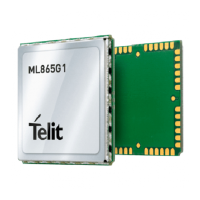displayed on the command line. When the sub parameter is not given in AT
commands that have a Read command, new value is equal to its previous value. In
AT commands that do not store the values of any of their sub parameters, and
therefore do not have a Read command, which are called
action type
commands,
an action should be performed according to the recommended default setting of
the sub parameter.
AT Command Syntax
The syntax rules followed by Telit implementation of either Hayes AT commands, GSM
commands are very similar to those of standard basic and extended AT commands
There are two types of extended command:
1. Parameter type commands. This type of commands may be "set" (to store a value
or values for later use), "read" (to determine the current value or stored values ),
or "tested" (to determine ranges of values supported). Each of them has a test
command (trailing =?) to provide information about the type of its sub parameters;
they also have a Read command (trailing?) to check the current values of sub
parameters.
2. Action type commands. This type of command may be "executed" or "tested".
1. "executed" to invoke a function of the equipment, which generally involves more
than the simple storage of a value for later use
2. "tested" to determine:
1. if sub parameters are associated with the action, the ranges of sub parameters
values that are supported; if the command has no sub parameters, issuing
the correspondent Test command (trailing =?) raises the result code
"ERROR".
Note: issuing the Read command (trailing?) causes the command to be
executed.
2. whether the equipment implements the Action Command or not (in this case
issuing the correspondent Test command - trailing =? - returns the OK
result code), and, if sub parameters are associated with the action, the
ranges of sub parameters values that are supported.
Action commands do not store the values of any of their possible sub parameters.
Moreover:
The response to the Test Command (trailing =?) may be modified in the future by Telit to
allow for the description of new values/functionalities.

